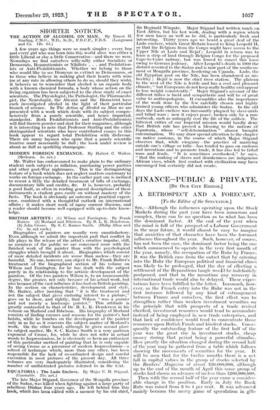BRITISH ARTISTS : (1) Wilson and Farrington. By Frank Rutter.
(2) Morland and Ibbetson. By B. L. K. Henderson. (3) John Crome. By S. C. Kaines Smith. (Philip Allan and " Co: 5s. net each.) Biographies of painters are usually very unsatisfactory. Even although we admit the important part that conflict in life plays in the release of the artist's creative impulse, still, as members of the public we are concerned more with the finished work of the painter than with the psychological struggles which brought it about. Biographies which consist of mere detailed incidents are worse than useless—they are harmful. No one, however, can object to Mr. Frank Rutter's treatment of the biographical section of his volume on Wilson and Farrington, for he has dealt with the subject purely in its relationship to the artistic development of the painters. Of the two painters Wilson is, to an immeasurable degree, the greater, not only because of his actual work, but also because of the vast influence it has had on British painting. In the section on characteristics, development and style, Mr. Rutter, after insisting that " it is the treatment and not the subject that gives enduring interest to a picture," goes on to show, and rightly, that Wilson " was a painter and not merely a landscape painter." This attitude is greatly contrasted to that of Dr. B. L. K. Henderson in his volume on Morland and Ibbetson. His biography of Morland consists of finding excuses and reasons for the painter's bad habits, while he touches on the development of the painter only in so far as it concerns the subject matter of Morland's work. On the other hand, although he gives second place to subject matter, Mr. S. C. Kaines Smith is a very partisan exponent of Crome, for, while he does not refer in actual words to Impressionism, he is obviously so keen an enthusiast of this particular method of painting that he is only capable of seeing Crome as a precursor of modern Impressionism—a school of technique which, more than any other, has been responsible for the lack of co-ordinated design and careful execution in most pictures of the present day. All three volumes are very inadequately illustrated, considering the number of unillustrated pictures referred to in the text.


































 Previous page
Previous page